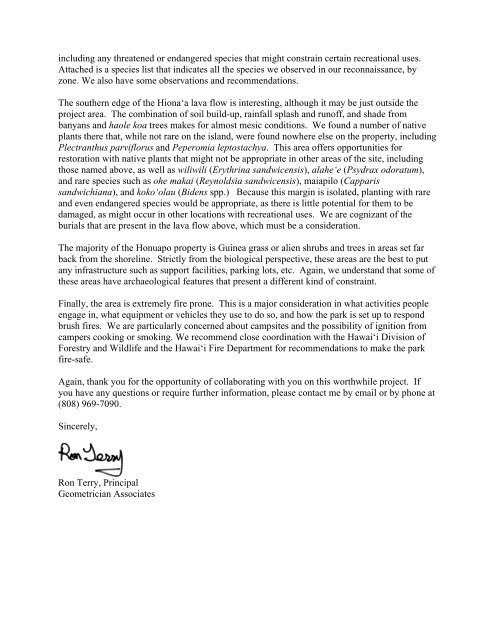Honu'apo Park Resource Management Plan
Honu'apo Park Resource Management Plan
Honu'apo Park Resource Management Plan
You also want an ePaper? Increase the reach of your titles
YUMPU automatically turns print PDFs into web optimized ePapers that Google loves.
including any threatened or endangered species that might constrain certain recreational uses.<br />
Attached is a species list that indicates all the species we observed in our reconnaissance, by<br />
zone. We also have some observations and recommendations.<br />
The southern edge of the Hiona‘a lava flow is interesting, although it may be just outside the<br />
project area. The combination of soil build-up, rainfall splash and runoff, and shade from<br />
banyans and haole koa trees makes for almost mesic conditions. We found a number of native<br />
plants there that, while not rare on the island, were found nowhere else on the property, including<br />
Plectranthus parviflorus and Peperomia leptostachya. This area offers opportunities for<br />
restoration with native plants that might not be appropriate in other areas of the site, including<br />
those named above, as well as wiliwili (Erythrina sandwicensis), alahe‘e (Psydrax odoratum),<br />
and rare species such as ohe makai (Reynoldsia sandwicensis), maiapilo (Capparis<br />
sandwichiana), and koko‘olau (Bidens spp.) Because this margin is isolated, planting with rare<br />
and even endangered species would be appropriate, as there is little potential for them to be<br />
damaged, as might occur in other locations with recreational uses. We are cognizant of the<br />
burials that are present in the lava flow above, which must be a consideration.<br />
The majority of the Honuapo property is Guinea grass or alien shrubs and trees in areas set far<br />
back from the shoreline. Strictly from the biological perspective, these areas are the best to put<br />
any infrastructure such as support facilities, parking lots, etc. Again, we understand that some of<br />
these areas have archaeological features that present a different kind of constraint.<br />
Finally, the area is extremely fire prone. This is a major consideration in what activities people<br />
engage in, what equipment or vehicles they use to do so, and how the park is set up to respond<br />
brush fires. We are particularly concerned about campsites and the possibility of ignition from<br />
campers cooking or smoking. We recommend close coordination with the Hawai‘i Division of<br />
Forestry and Wildlife and the Hawai‘i Fire Department for recommendations to make the park<br />
fire-safe.<br />
Again, thank you for the opportunity of collaborating with you on this worthwhile project. If<br />
you have any questions or require further information, please contact me by email or by phone at<br />
(808) 969-7090.<br />
Sincerely,<br />
Ron Terry, Principal<br />
Geometrician Associates


